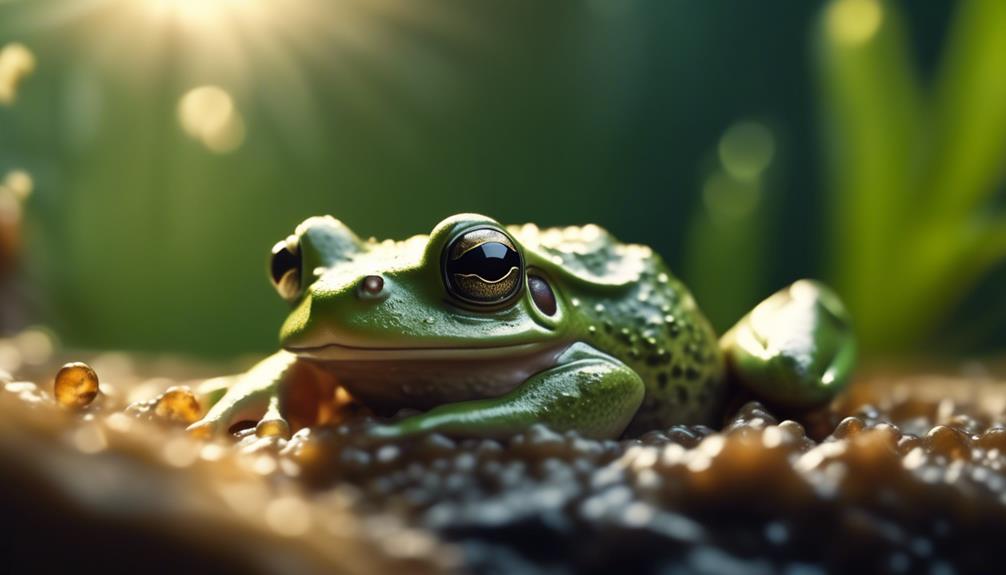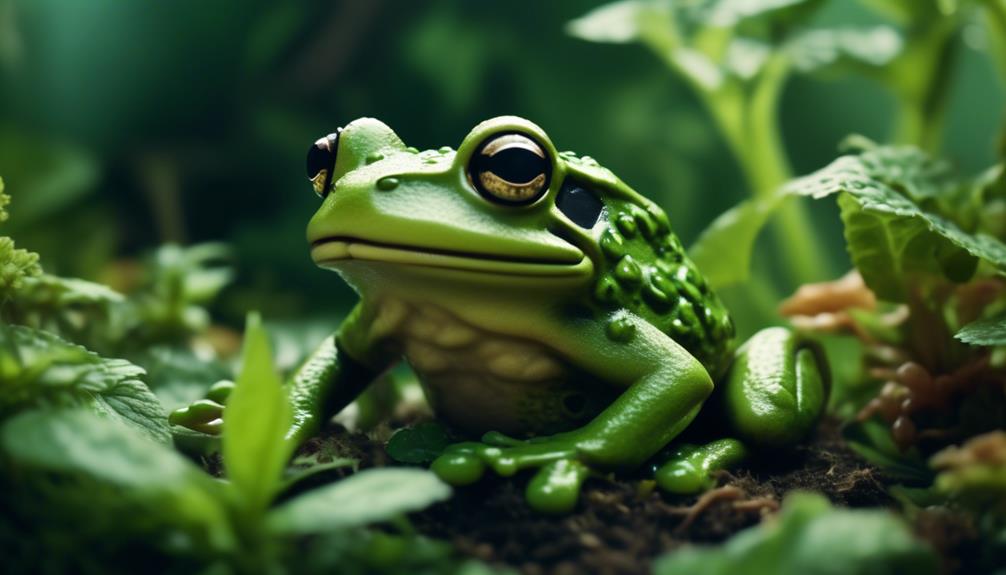Frogs, those fascinating amphibians that inhabit our wetlands and forests, have long captivated the curiosity of scientists and nature enthusiasts alike. While we often associate frogs with their ability to adapt to various habitats and their distinct croaking, one aspect that remains shrouded in mystery is their apparent aversion to mint. Yes, you read that correctly – mint. Have you ever wondered why frogs seem to recoil at the mere scent of this refreshing herb? In order to unravel this intriguing phenomenon, we must delve into the intricacies of their sensitive skin, the unique taste receptors they possess, and the chemical compounds found in mint that may trigger their aversion. So, let us embark on this scientific journey as we seek to uncover the secrets behind the frog-mint interaction and the evolutionary factors that may have shaped this peculiar preference.
Key Takeaways
- Frogs have sensory adaptations that allow them to detect changes in the environment and identify potentially toxic or unsuitable food sources.
- The high concentration of menthol in mint repels frogs and disrupts their feeding behavior.
- Mint compounds interfere with frog's chemical communication and may deter them from inhabiting areas where mint is present.
- Frogs' aversion to mint is an evolutionary response, shaped by the aversive effects of mint compounds over time.
The Sensitive Skin of Frogs

The sensitive skin of frogs plays a crucial role in their survival and overall well-being, as it allows them to efficiently sense and respond to their aquatic and terrestrial environments. This evolutionary adaptation enables them to perceive and interpret a wide range of sensory information, aiding in their ability to navigate and interact with their surroundings.
Frogs have a unique skin structure that is specifically designed to facilitate sensory perception. Their skin is thin and permeable, allowing for the efficient exchange of gases and water through their body. This feature also enables them to absorb moisture and essential nutrients directly through their skin, making it an essential organ for their overall health and well-being.
Furthermore, the skin of frogs is covered in small, specialized structures called sensory papillae. These papillae contain sensory cells that are capable of detecting various stimuli, such as temperature, pressure, and chemical cues. This allows frogs to detect changes in their environment and respond accordingly, whether it be seeking shelter from predators or finding a suitable habitat for reproduction.
The sensory perception capabilities of frog skin extend beyond their terrestrial environment. In water, the skin plays a vital role in gas exchange, allowing frogs to effectively breathe through their skin. Additionally, their skin is highly sensitive to vibrations, enabling them to detect the presence of prey or potential predators in the water.
Unique Taste Receptors in Frogs
Frogs possess distinctive taste receptors that play a crucial role in their ability to perceive and respond to different flavors in their environment. These unique taste receptors are a result of the frogs' adaptation to their specific ecological niche and are essential for their survival. Frogs, like other animals, rely on their sensory perception to navigate their surroundings and make informed decisions about their food choices.
The taste receptors in frogs are specialized cells located on their tongues and the lining of their mouths. These receptors are responsible for detecting and interpreting different chemical compounds present in their food. Through these receptors, frogs can distinguish between bitter, sweet, sour, and salty tastes. This ability allows them to identify and reject potentially toxic or unsuitable food sources.
Studies have shown that frogs' taste receptors are highly sensitive and finely tuned to detect specific chemical compounds. This sensitivity is crucial for their survival, as it helps them identify and avoid potential threats. For example, frogs have been found to have a strong aversion to the taste of mint. This aversion is believed to be a result of an evolutionary adaptation that helped frogs avoid plants containing toxic compounds.
Furthermore, frogs' taste receptors also play a role in their reproductive behavior. Female frogs, for instance, are able to detect the presence of specific pheromones released by males during the breeding season. This sensory perception allows them to choose suitable mates and ensures successful reproduction.
The Role of Mint in Frog Predation

Mint, a common herb known for its strong aroma and refreshing taste, has been found to have an intriguing role in frog predation. The interaction between frogs and mint has been the subject of scientific investigation, revealing the impact of mint on frog behavior. Here are three key findings that shed light on the relationship between frogs and mint:
- Deterrent effect: Mint possesses a distinct odor due to its high concentration of menthol, which is known to repel many species of animals. Studies have shown that the scent of mint can deter frogs from approaching areas where it is present. This suggests that frogs may have evolved to associate the smell of mint with danger or unpalatable prey, leading them to avoid mint-infested environments.
- Disruption of feeding behavior: Mint's strong aroma can also disrupt the feeding behavior of frogs. When exposed to mint, frogs have been observed to show a decreased interest in food sources, as the scent interferes with their ability to detect and locate prey. This disruption in feeding behavior can have a significant impact on the survival and reproductive success of frogs in mint-rich habitats.
- Chemical defense mechanism: Mint contains compounds called monoterpenes, which have been found to have toxic effects on certain organisms. When frogs come into contact with mint, these monoterpenes may be absorbed through their skin, leading to physiological changes or even toxicity. This chemical defense mechanism of mint could serve as a natural deterrent against frog predation, further explaining the aversion that frogs exhibit towards mint.
The role of mint in frog predation highlights the complex interplay between plants and animals in natural ecosystems. Further research is needed to fully understand the mechanisms underlying frog-mint interactions and their ecological implications.
Chemical Compounds in Mint and Frog Sensitivity
Chemical compounds present in mint have been found to elicit various physiological and behavioral responses in frogs, indicating their sensitivity to these compounds. Frogs, like many other organisms, have evolved a range of sensory mechanisms to detect and respond to chemical cues in their environment. The ability to detect and respond to specific chemicals is crucial for survival, as it allows frogs to navigate their surroundings, find suitable mates, and avoid potential dangers.
Evolutionary adaptations have shaped frogs' sensitivity to chemical compounds in mint. Mint contains a variety of volatile organic compounds, such as menthol and menthone, which give it its distinct aroma. These compounds can trigger a range of responses in frogs, including avoidance behavior, altered feeding patterns, and changes in physiological parameters.
Chemical communication plays a vital role in the lives of frogs. They use chemical cues to communicate with conspecifics, recognize potential mates, and establish territories. The sensitivity of frogs to mint compounds suggests that these chemicals may interfere with their ability to detect and interpret important chemical signals.
Furthermore, the sensitivity of frogs to mint compounds may have ecological implications. Mint plants, with their strong aroma, could potentially deter frogs from inhabiting areas where they are present. This may impact the distribution and abundance of frog populations, as well as their interactions with other species in the ecosystem.
Evolutionary Factors Behind Frog Aversion to Mint

The aversion of frogs to mint can be attributed to evolutionary factors that have shaped their sensitivity to certain chemical compounds. Over time, frogs have developed specific adaptations that allow them to detect and avoid harmful substances in their environment, including the compounds found in mint. Here are three important evolutionary factors behind frog aversion to mint:
- Sensory perception: Frogs possess specialized sensory organs that enable them to detect a wide range of chemical cues in their surroundings. This includes the ability to perceive and respond to the distinct odor and taste of mint. Through the process of natural selection, frogs with a heightened sensitivity to mint compounds were more likely to survive and reproduce, passing on their genetic traits to subsequent generations.
- Defensive mechanism: Mint plants produce a variety of compounds, such as menthol and pulegone, that serve as natural defense mechanisms against herbivores. These compounds can be toxic or irritating to many animals, including frogs. Through the process of coevolution, frogs that developed an aversion to mint compounds were less likely to consume these plants, reducing their risk of encountering harmful toxins and increasing their chances of survival.
- Ecological niche: Frogs occupy a specific ecological niche within their habitats, and their aversion to mint compounds may be influenced by their dietary preferences and interactions with other organisms. For example, some studies suggest that certain frogs may avoid mint because it interferes with their ability to detect and capture their prey, which could ultimately impact their survival and reproductive success.
Implications and Applications of Frog-Mint Interaction
The frog's aversion to mint has potential implications for various fields, including agriculture, pest control, and conservation. Mint's repellent effect on frogs suggests that it could be used as a natural deterrent to keep frogs away from certain areas or crops. Understanding the natural preferences of frogs can also aid in conservation efforts by helping to protect their habitats and ensure their survival. These implications highlight the importance of further research and exploration of the frog-mint interaction.
Mint's Repellent Effect
Mint's repellent effect on frogs has significant implications and potential applications in understanding the intricate dynamics of predator-prey relationships in terrestrial ecosystems. This evolutionary adaptation of frogs to avoid mint provides valuable insights into the ecological implications of chemical defenses in prey species. Here are three key implications and applications of the mint's repellent effect on frogs:
- Predator avoidance: Mint's repellent properties serve as an effective defense mechanism for frogs, deterring potential predators. By understanding the specific compounds responsible for this repellent effect, scientists can develop strategies to protect other vulnerable species from predation.
- Conservation strategies: The identification and utilization of mint's repellent effect can contribute to the development of novel conservation strategies. By incorporating mint or its key compounds into predator deterrents, conservationists can better protect frogs and other species in threatened ecosystems.
- Ecological balance: The mint's repellent effect highlights the delicate balance between predators and prey in terrestrial ecosystems. Studying this interaction can enhance our understanding of the complex web of relationships and contribute to the conservation and management of biodiversity.
Natural Frog Preferences
The interaction between frogs and mint has significant implications and applications in understanding natural frog preferences and their potential impact on terrestrial ecosystems. Natural frog behaviors are influenced by various environmental factors, which can shape their preferences for certain habitats, food sources, and even plant species. Frogs exhibit a wide range of behaviors, such as mating rituals, territoriality, and foraging strategies, which can be influenced by their preferences for specific environmental conditions. Environmental factors affecting frog preferences include temperature, humidity, water availability, vegetation density, and prey abundance. By studying the interaction between frogs and mint, researchers can gain insights into the natural behaviors and preferences of frogs, which can contribute to our understanding of ecosystem dynamics and aid in conservation efforts. Understanding frog preferences and their responses to environmental factors is crucial for maintaining healthy and balanced terrestrial ecosystems.
Frequently Asked Questions
How Do Frogs Benefit From Having Sensitive Skin?
Frogs benefit from having sensitive skin in various ways. Their skin plays a crucial role in respiration, as it allows for the exchange of gases with the environment. Additionally, the skin acts as a protective barrier, preventing the loss of body fluids, while also serving as a means of thermoregulation. The sensitivity of their skin helps frogs detect changes in temperature, humidity, and water quality, enabling them to adapt and survive in their environments. This evolutionary adaptation has allowed frogs to thrive in diverse habitats worldwide.
What Other Types of Taste Receptors Do Frogs Have Besides the Ones That Detect Mint?
Frogs possess a remarkable array of taste receptors that enable them to detect a wide range of chemicals in their environment. These receptors, besides detecting mint, allow frogs to identify various other substances. The impact of mint on frogs' behavior is thought to be linked to the presence of certain compounds that might be perceived as aversive by the frogs. However, it is important to consider other factors, such as evolutionary adaptations and individual preferences, that may contribute to a frog's aversion to mint.
How Does Mint Affect the Hunting Behavior of Frogs?
The effect of mint on frogs' feeding habits and the impact it has on their hunting efficiency is a topic of interest in the field of frog biology. Research suggests that the presence of mint can deter frogs from hunting prey effectively. The strong scent of mint may interfere with their olfactory system, making it difficult for them to detect and catch their prey. Furthermore, certain compounds in mint may have a repellent effect on frogs, causing them to avoid areas with mint plants or substances. Further research is needed to fully understand the mechanisms behind this phenomenon.
Can Frogs Detect Other Types of Chemical Compounds Besides the Ones Found in Mint?
Frogs possess a remarkable ability to detect and distinguish various chemical compounds. Their olfactory system is finely tuned, enabling them to perceive a wide range of scents in their environment. This sensory prowess extends beyond mint-related compounds, as frogs can detect and respond to a diverse array of chemical cues. Their capacity to identify different scents plays a crucial role in their survival, aiding in foraging, mating, and predator avoidance. Understanding the intricacies of frogs' olfaction system opens up fascinating avenues for further research in chemical ecology.
Are There Any Other Factors Besides Evolution That Contribute to Frogs' Aversion to Mint?
There are various factors that contribute to frogs' aversion to mint, apart from evolution. Non-evolutionary influences on frogs' mint aversion can include sensory perception, taste sensitivity, and chemical reactions within their bodies. Frogs possess a highly developed olfactory system, allowing them to detect and respond to different chemical compounds. Additionally, their taste buds may be sensitive to specific substances found in mint. Furthermore, the chemical composition of mint may interact with the frogs' physiological processes, leading to an aversive response.
Conclusion
In conclusion, the aversion of frogs to mint can be attributed to their sensitive skin and unique taste receptors. The chemical compounds present in mint may trigger negative reactions in frogs, leading to their avoidance of this aromatic herb. This intriguing phenomenon highlights the intricate relationship between animals and their environment, shedding light on the evolutionary factors that shape their preferences. Further research in this area could have significant implications for understanding predator-prey interactions and developing novel pest control methods.

